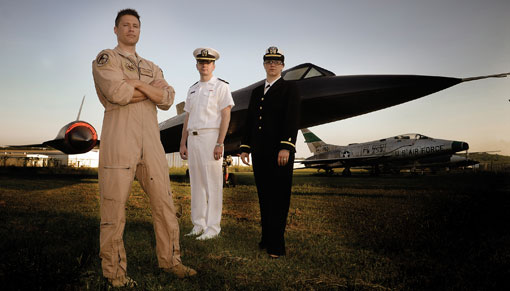Mixing Military Life and Medical School
By Doug Gillett
 |
Jason Patten (left) and Scott and Rozalyn Love are three of approximately 20 students from the UAB School of Medicine who are serving in the military in some capacity. |
These days Jason Patten is most likely found in one of two places: in a classroom at the UAB School of Medicine, or in the cockpit of an F-16 high above Alabama.
After six years of training and flying with the Air National Guard post in Montgomery, Patten began applying to medical schools in 2006. Now he’s a third-year student living two of his childhood dreams at once—being a doctor and a fighter pilot. “It’s a lot of work balancing everything, but it’s worth it,” he says. “I have no complaints.”
The balancing act means that Patten sometimes must attend classes, then drive to Montgomery the same night to practice his dogfighting skills with fellow pilots. And regular deployments to the Middle East have challenged him to keep up with classes from 5,000 miles away.
Fortunately, Patten says, both UAB and the Pentagon have gone out of their way to help him manage his twin responsibilities. His SOM mentor—Sarah Nafziger, M.D., a professor in the Department of Emergency Medicine—worked with the Air Force to help coordinate his combat and research schedules. And the SOM’s curriculum structure enabled Patten to participate in a number of research projects on the ground in Iraq.
Patten worked on studies of compartment syndrome and traumatic brain injury. “We were looking at the use of 3-percent saline, which is commonly used in head injuries,” he explains. “But with IEDs exploding, this was the first time we were seeing high-impact, high-velocity trauma on a constant basis. We just don’t have this kind of data in America, but in Iraq it happened twice a day.”
Medical Commission
Meanwhile, fellow medical students Rozalyn and Scott Love have faced their own balancing act—military service, medical school, and a marriage. They were commissioned as naval officers in April 2007 and started SOM classes just three months later.
Rozalyn says they were attracted to military service by the adventure, but also by its opportunities for both health care and public policy. (Both she and Scott earned master’s degrees at UAB’s School of Public Health.) Like Patten, they’ve been helped by professors and commanding officers who have tried to make their experience as seamless as possible.
Thanks to the Navy Health Professions Scholarship Program, the Loves have been able to concentrate on their SOM coursework during the school year and serve their active-duty time during the summer. After their first year, they attended a five-week officer development program in Rhode Island; the next year, they spent the summer doing research at Naval Medical Center San Diego.
Scott says they may return to San Diego for their residency. “The Navy doesn’t do an official couples match, but they mostly try to keep you together, so I’m pretty confident we’ll be together for at least the first year,” he says. “After that, our paths may diverge a bit, but we knew that was a risk.”
Following their residencies, the Loves will owe the Navy four years of active service—no minor commitment, but one that Rozalyn describes as preferable to graduating with hundreds of thousands of dollars in student-loan debt. Even more important than the financial considerations, though, is the sense of serving one’s country.
Rozalyn says she felt that acutely when she met with her great-great-uncle, a World War II veteran, just days after graduating from officer training. “We walked into the room, and he summoned the strength to push himself up out of his wheelchair to stand and give us our first salute. He passed away very shortly after that, and we got to present the flag to his family at his military funeral,” she recalls. “You just don’t appreciate the sacrifices that a lot of our forefathers have made until you tell them you’re joining the service.”
This article originally appeared in the Fall/Winter 2010 issue of UAB Medicine, the magazine of the UAB School of Medicine.